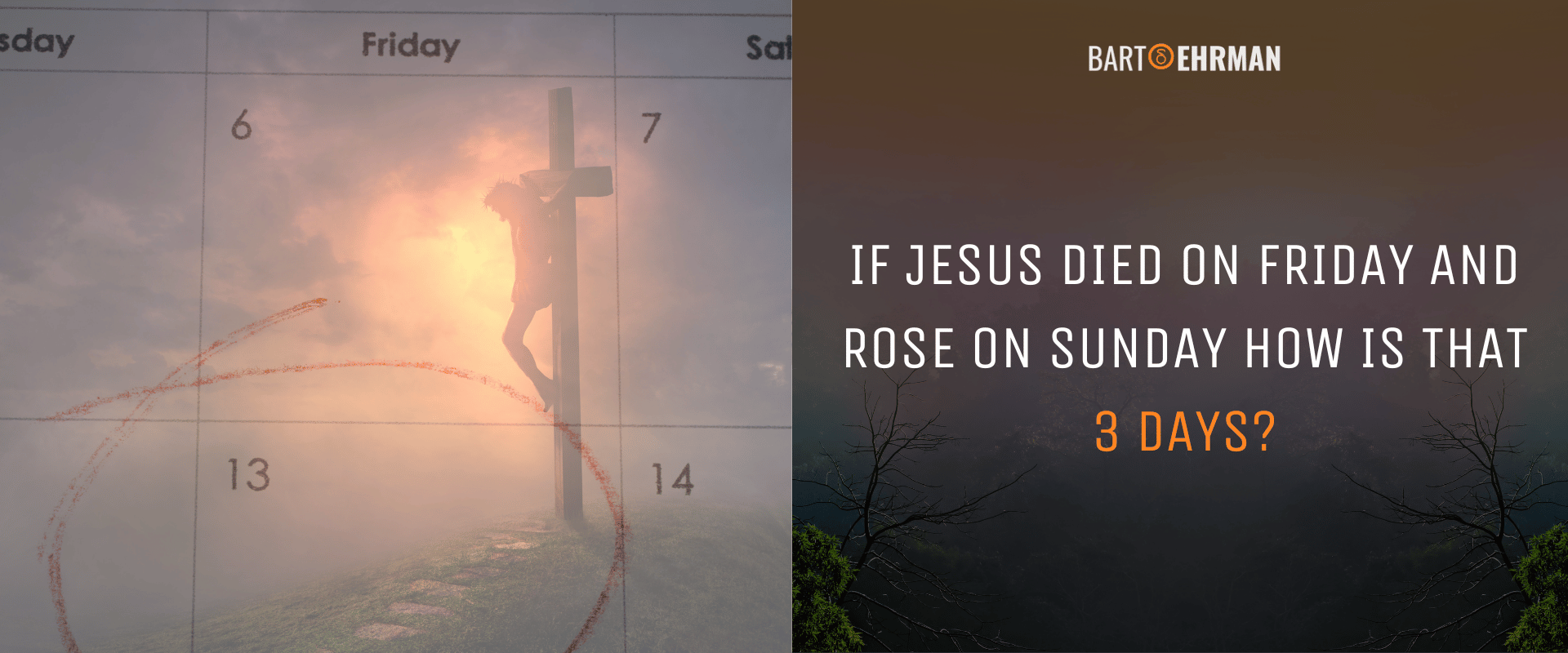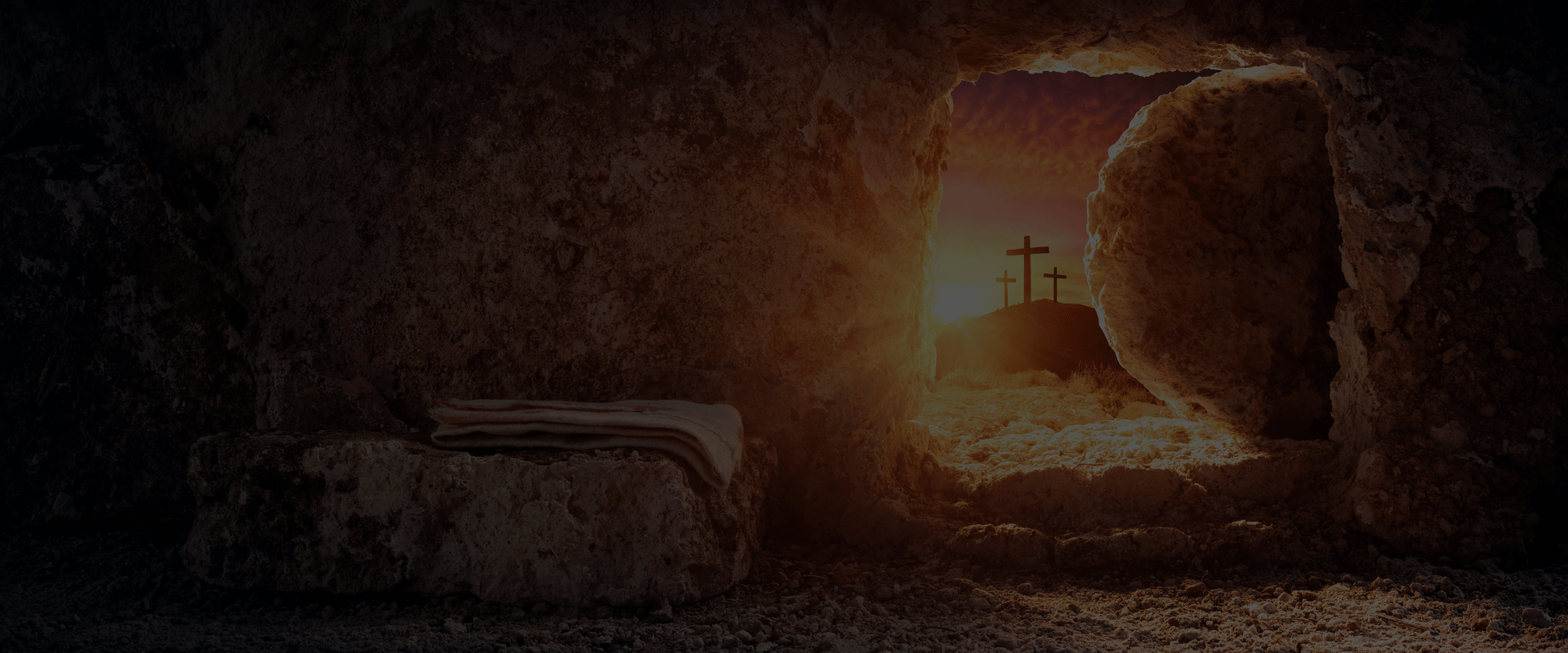If Jesus Died on Friday and Rose on Sunday How is That 3 Days?

Written by Joshua Schachterle, Ph.D
Author | Professor | Scholar
Author | Professor | BE Contributor
Verified! See our editorial guidelines
Verified! See our guidelines
Date written: June 29th, 2024
Disclaimer: The views and opinions expressed in this article belong to the author and do not necessarily match my own. - Dr. Bart D. Ehrman
The concept of Jesus' resurrection "on the 3rd day" stands as a cornerstone of Christian faith, echoing through millennia of theological discourse and shaping the redemption narrative. This belief finds its roots not only in the Gospels but in our earliest Christian writings, the letters of Paul. But if Jesus died on Friday and rose on Sunday, how is that 3 days?
In this article, I’ll explore the origins and interpretations of the "3 days" theme across the canonical Gospels, dissecting how each narrative frames the timeline from Jesus' death to his resurrection. This will include questions of Jewish time reckoning and the theological significance attached to the 3rd day, explaining how early Christians understood and interpreted the crucial period between Jesus’ death and his resurrection.

Where Did the Idea of the 3 Days Come From?
Our first reference to the 3 days leading to Jesus’ resurrection comes not from the Gospels but from our oldest source of Christian writing, Paul. In 1 Corinthians 15:3-8, Paul writes that he is passing on to his readers what he learned as a new convert, including that Jesus was crucified and “was raised on the third day in accordance with the Scriptures.”
Since 1 Corinthians was written only about 20 years after Jesus’ death, we can be sure that this was a very old belief among Christians, established long before the Gospels were written. However, the idea was attributed to Jesus through predictions in the canonical Gospels.
Initially, the Gospels have Jesus predicting his cruel death and resurrection. Mark, our oldest Gospel, provides the first model for this in Mark 8:31, and then again in Mark 9:31-32 where Jesus says, “The Son of Man is to be betrayed into human hands, and they will kill him, and three days after being killed, he will rise again.” Note that he says he will rise 3 days after being killed.
The Gospel of Matthew, although using Mark as a source, adds a bit to the story in Matthew 12:40, where Jesus, when asked by scribes and Pharisees for a sign of his authority, says “just as Jonah was three days and three nights in the belly of the sea monster, so for three days and three nights the Son of Man will be in the heart of the earth.”
Later, in Matthew 16:21-28, Jesus says almost the same phrase as in Mark, although, in this case, it is “on the third day” rather than specifying the third day after his death. Matthew’s Jesus repeats his prediction in 17:20-22 while Luke 9:21-22 uses the same phrase.
The Gospel of John which often differs from the Synoptics, has Jesus predict his death more obliquely. For example, in John 3:14, Jesus tells his interlocutor Nicodemus “Just as Moses lifted up the snake in the wilderness, so the Son of Man must be lifted up that everyone who believes may have eternal life in him.” This is a reference to the episode in Numbers 21:1-9 in which God instructs Moses to make a bronze serpent and hold it up on a pole so that any Israelites who see it will not die from the poisonous bites of the snakes attacking them.
In John 12:23-24, Jesus uses another metaphorical reference to his death: “Most assuredly, I say to you, unless a grain of wheat falls into the ground and dies, it remains alone; but if it dies, it produces much grain.” Both of these sayings, though, focus mainly on the salvific aspect of his death and don’t explicitly predict his resurrection, although the phrase “produces much grain” may be a reference to his resurrection.
Due to all of these predictions, it would have been unthinkable for the Gospel writers — writing 4-7 decades after the events had occurred — to believe that the resurrection had not happened in 3 days exactly as Jesus had predicted.
Having seen the origin of the notion of the three days in the Gospels, let’s look at how they describe the timeline from Jesus’ death to his resurrection.
What Day Did Jesus Die in the Gospel of Mark?
In order to count the days between Jesus’ death and his resurrection as told in the Gospels, we need to start by understanding a bit about the Jewish calendar. Jesus was, of course, a Jew living in Palestine, and three of the four Gospel authors were Jewish as well (Luke was probably a Gentile). This means they assumed their readers would understand the Jewish calendar.
This is a big topic, but I’ll just discuss the way days are measured here. Unlike the Gregorian calendar most people use now, the Jewish calendar measures a day from sunset to sunset. This is why the Sabbath in Judaism, which is Saturday, starts on Friday evening.
Although all four Gospels assume this day-counting method, there are slight differences between some of their accounts. For example, the Gospel of Mark, says that Jesus’ Last Supper was a Passover meal. Passover was the most important celebration for 1st-century Jews, since it commemorated God’s salvation of the Israelites from slavery in Egypt.
For Mark, this took place on a Thursday evening. How do we know this? Because Mark 15:42 tells us that Jesus’ death and burial happened on the day before the Sabbath, which is always counted from sundown Friday to sundown Saturday.
Not long after this meal on Thursday, Jesus is arrested, spends the night in jail, and is tried by Pilate in the morning. He is then crucified at 9:00 AM. Because Passover started the previous evening, he is crucified on the day of Passover. In other words, Jesus died on Good Friday.
Although the original ending of the Gospel of Mark does not include any appearances of the risen Jesus, it does speak of his empty tomb. Mark 16:1 says that women went to Jesus’ tomb to properly anoint his body “when the Sabbath was over,” specifically “very early on the first day of the week, when the sun had risen.”
For Jews, the Sabbath was over on Saturday at sundown, and the first day of the week was Sunday. That is, Jesus was resurrected sometime between Saturday night — the beginning of the first day of the week — and Sunday morning, when the women discovered the empty tomb. The timeline of these events in Mark would look like this:
Thursday night: Last Supper, Jesus is arrested.
Friday morning: Jesus is tried and crucified.
Friday afternoon: Jesus is buried.
Sunday morning: Jesus is resurrected.
The Gospels of Matthew and Luke, both of which used Mark as a source, agree with Mark’s timeline. The Gospel of John, however, differs a bit.
What Day Did Jesus Die in John?
In the Gospel of John, the Passover begins on Friday at sundown, but Jesus’ Last Supper is on Thursday, the evening before. So, the Last Supper is not a Passover meal in John’s Gospel.
After it occurs, Jesus is arrested, spends the night in jail, and is tried by Pilate the following morning. His crucifixion occurs just after noon on the day before the Passover meal celebration. Additionally, this Passover coincides with the Sabbath, Saturday. This was very rare since the Sabbath occurs every Saturday, while Passover always occurs on the 15th day of the Jewish month of Nisan and could, therefore, occur on any day of the week. Finally, Mary Magdalene finds Jesus’ empty tomb on Sunday morning.
John’s timeline, then, would look like this:
Thursday night: The Last Supper and Jesus is arrested.
Friday morning: Jesus is tried.
Friday at noon: Jesus is crucified.
Friday afternoon: Jesus is buried.
Sunday morning: Jesus is resurrected.
Note that despite the differences in chronology, both the Synoptic Gospels and John say that Jesus died on Friday and was resurrected on Sunday. But since all the Gospels say that he was resurrected “on the third day,” how are they counting? If Jesus died on Friday and rose on Sunday, how is that 3 days?

Scholarly Explanations of the Three Days
One scholar, Ben Witherington III, writes that, while modern people are obsessed with precision in time, privy as we are to precise timing instruments, ancient people didn’t have that luxury. Time was thus measured approximately in the ancient world, and that includes Jesus’ predictions of his resurrection in the Gospels.
Witherington thus argues that “the phrase ‘after three days’ in the New Testament can simply mean ‘after a while’ or ‘after a few days,’ without any clear specificity beyond suggesting several days.” While the lack of precision in ancient measurements of time is undeniable, it’s an open question whether the notion of three days would have been so carelessly tossed off.
A far more likely explanation, in my humble opinion, has to do with how things were counted in the ancient Mediterranean world. In the modern world, we use what is called exclusive counting, meaning that our starting point for counting is 0. By contrast, in his book The History and Practice of Ancient Astronomy, James Evans writes that ancient Rome and its surrounding cultures used inclusive counting; their starting point was 1. (Affiliate Disclaimer: We may earn commissions on products you purchase through this page at no additional cost to you. Thank you for supporting our site!)
Applied to the resurrection stories in the Gospels, this would mean that Friday, the day Jesus was executed and buried, was day 1. Day 2, then was Saturday, and day 3 was Sunday. This would mean that in ancient systems of counting, Jesus indeed rose “on the 3rd day.”
This is correct, even for the verses that say “after three days,” since, according to Bart Ehrman, any part of a day counted as a full day in ancient Judaism. While Witherington is no doubt correct about the imprecision of time measurement in the ancient world, the system of inclusive counting is the more likely reason Friday to Sunday would have been reckoned as 3 days.
Conclusion
To the modern mind, recounted facts are either 100% true or 100% false. If, therefore, Jesus said that he would be raised from the dead “on the 3rd day,” it either happened exactly 72 hours after he expired on the cross, or it didn’t. This has occasionally led modern interpreters, especially in religious contexts, to try to explain how Sunday could be the 3rd day if Jesus died on a Friday.
The very notion of the 3 days has its textual origins first in the letters of Paul, who confirms for his audience that Jesus was raised on the 3rd day as an important article of faith. We then see this written as a prediction from the mouth of Jesus in the Synoptic Gospels, although his predictions in John are a bit more circumspect.
Even though the Synoptics and John differ on chronology of the events of Jesus’ last week, they agree that he died and was buried on Friday and then raised on Sunday. By our count, that only seems like two days, with Friday being day zero.
In the ancient world, it’s quite likely that, without watches or cell phones, it was impossible for people to measure time with the exactitude we can now. Instead, perhaps “3 days” merely meant “a few days,” as Ben Witherington III says, and the actual number wasn’t as vitally important as it seems now.
In addition, people counted in the ancient world starting from 1 rather than 0. This means that Friday , the day of Jesus’ death, was actually day 1 for the Gospel writers. Saturday, the Sabbath, was day 2, making Sunday the all-important 3rd day when the empty tomb was found.

